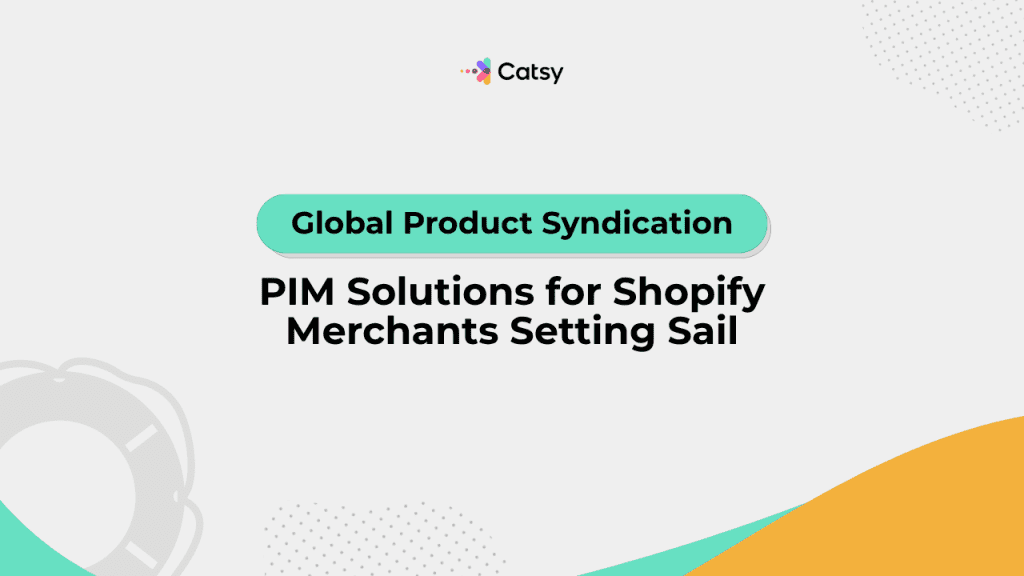How Shopify Stores Can Chart Their Course with PIM for Worldwide Product Syndication
Global product syndication refers to the distribution of consistent and accurate product information across multiple, international channels. This process involves more than just replication of data! It requires consistent, accurate, and timely content adaptation and compliance management.

Table of Contents
- Global Product Syndication: Charting Your Course in International Waters
- Why Global Product Syndication is Your Trade Wind to Shopify Growth
- Top 5 Navigational Strategies to Achieve Seamless Global Product Syndication
- Tales from the High Seas: Proven Examples of Global Syndication Success
- Finding Your North Star: The Value of Expert Content Strategy Partnership
What You’ll Learn: Your Navigation Chart
- How to navigate product information management across multiple global Shopify stores using centralized PIM systems as your compass
- Strategic approaches to sail through cross-border syndication challenges while maintaining steady data consistency and compliance
- Proven implementation strategies that catch favorable winds to accelerate time-to-market and reduce operational overhead for international expansion
In this Article
Global Product Syndication: Charting Your Course in International Waters
According to Capital One Shopping, retail e-commerce sales are projected to surpass $6.42 trillion worldwide in 2025, representing a 6.86 percent year-over-year increase.
For Shopify merchants wishing to hoist their global sales, this represents both a huge opportunity and a complex challenge. It’s like charting a course through vast oceans of potential.
Setting Your Bearings: Understanding Global Product Syndication
Global product syndication refers to the distribution of consistent and accurate product information across multiple, international channels. This process involves more than just replication of data! It requires consistent, accurate, and timely content adaptation and compliance management.
The Voyage Ahead: Why This Matters for Your Fleet
So why should you get a better handle on your data management? Well, the significance extends well beyond operational efficiency. Today, merchants who can effectively plot a course for international expansion gain a substantial advantage over the competition.
Successfully navigating the complexities of multi-market product management can often lead to discovery of new trade routes to success. In this guide, we’ll look at how.
Why Global Product Syndication is Your Trade Wind to Shopify Growth
Catching the Winds of Cross-Border Commerce
Cross-border e-commerce presents one of the most significant growth opportunities for today’s digital merchants—like discovering new continents of commerce waiting to be explored by intrepid captains.
Cross-border e-commerce presents a significant growth opportunity for many digital merchants! According to Raconteur, the global e-commerce market is predicted to be worth around $6.56 trillion by the end of 2025. Much of this growth can be attributed to mobile commerce and multichannel experiences.
Navigating Through the Doldrums of Manual Management
With manual product information management, the challenge lies in the execution. Shopify stores create bottlenecks when you’re trying to navigate your data to multi-national expansion efforts. You may find yourself struggling to maintain consistent pricing or accurate product descriptions. Your tech specs or even your translations may decline in quality, too, leading to lost sales opportunities.
Modern Consumers Expect Smooth Sailing
Today’s shoppers have come to expect perfection, regardless of where in the world they live. When your product info is different in the United States than it is in Europe, your customers will lose trust in your brand.
Global product syndication through PIM systems addresses these challenges by creating a single source of truth. Your PIM automatically distributes accurate, localized content across all channels, serving as your North Star for navigating data consistency.
Riding the Currents of Efficiency
As you scale, your data complexity grows. Liken it to navigation from safe harbors to the open sea. According to McKinsey research, AI-driven systems can boost workforce efficiency by 40 percent in product management while reducing the manual overhead associated with multi-store operations.
If you’re a Shopify merchant managing hundreds or thousands of SKUs globally, this efficiency gain translates to a huge bump in profit margins – and improved competitive positioning, too. It’s like upgrading from a galleon to a swift clipper on your commercial voyage.
Adjusting Your Sails to Market Winds
The current market environment requires agility as you scale internationally. Merchants who can quickly adjust their sales are better positioned to capture new opportunities.
[Image placeholder: Nautical map showing global e-commerce trade routes and multi-store management navigation points]
Make Catsy DAM and PIM Software an Extension of Your Team
Book a Free DemoTop 5 Navigational Strategies to Achieve Seamless Global Product Syndication
1. Drop Anchor with Centralized Product Information Management
The most critical step you’ll take in global navigation is establishing a single source of truth for your product data. This allows you to plot your expansion in a systematic and consistent way, even across global markets. A robust PIM can integrate with Shopify for seamless product data syndication.
Modern PIM solutions like Catsy offer advanced syndication capabilities that will automatically push updates to multiple Shopify stores simultaneously. As you update a product description or adjust a price within your PIM, the change will propagate across each of your stores. This eliminates manual effort and reduces the risk of inconsistencies that may damage your reputation with customers.
2. Chart Automated Courses for Localization and Compliance
Develop automated workflows that will adapt your product content to different markets. This helps you navigate the straits of international commerce because your updates will be automatically formatted to meet local requirements. From currency conversion to safety certifications, your PIM will guide your ship safely through.
Effective automation can reduce your time to market for new regions by up to 50 percent. Set clear instructions for language translations, regulatory compliance checks, and measurement conversions to quickly expand to new markets without impacting quality.
3. Build Your Armada with Multi-Channel Integration
Don’t just connect your PIM to Shopify! Consider social commerce platforms, regional marketplaces, and business-to-business channels, among others. A comprehensive approach will ensure that your products reach customers through their preferred platform – all while you maintain consistency across each of these outlets.
The most successful global merchants usually navigate between five to eight different sales channels per market. A well-configured PIM will be your flagship, sending the signals that feed your accurate data to Amazon, eBay, and other ports.
4. Navigate with Real-Time Inventory Sonar
Implement systems that give you real-time data about your inventory. This can prevent overselling situations that will damage your brand’s reputation. Inventory visibility ensures that your customers see the correct information regardless of their location.
Advanced inventory management features will help you find strategies that are based on the regions you’re selling in. When they’re integrated with your PIM system, these capabilities will ensure that your accurate availability information reaches each customer, no matter the platform they’re using.
5. Rig Your Ships for Scalable Content Enhancement
Develop systematic approaches to enhance your product content using rich media, detailed descriptions, and localized information. This involves creating templates that can be replicated over and over as you expand to new markets.
Effective content enrichment processes can increase your conversion rates by as much as 20 to 30 percent in global markets! By establishing clear standards for photography, descriptions, and other content, you create a framework that will scale with your business and maintain data quality.
Tales from the High Seas: Proven Examples of Global Syndication Success
Captain’s Tale 1: Luxury Fashion Retailer’s 19-Port Empire
According to Shopify, Antonioli, a luxury fashion retailer, transformed their global operations. They implemented a comprehensive PIM system to manage 56,000 products across 19 international platforms.
Before implementing their solution, the brand had struggled with inconsistent pricing and product information across regions. This led to customer confusion as well as operational inefficiencies.
Once they deployed their PIM-driven syndication strategy, Antoniolo was able to consolidate their price lists, and they maintained consistent product details on a global level. This resulted in a 20 percent increase in turnover growth.
The automated syndication capabilities enabled the retailer to launch new collections simultaneously across all markets while ensuring compliance with local port authorities and currency requirements.
Captain’s Tale 2: Dutch Marketplace Weathering the Storm
According to Shopify’s blog, Oletti is a Dutch home goods marketplace that also saw gains from PIM technology. They leveraged their PIM to manage multiple vendor relationships, all while maintaining consistent product information across their Shopify stores.
When the COVID-19 pandemic drove rapid growth, their manual processes became unsustainable for managing large product catalogs with multiple suppliers.
By implementing Fixpoint’s PIM solution, Oletti automated vendor uploads and inventory tracking across multiple Shopify stores! This enabled them to scale their business while still maintaining accurate product data. Customer experiences across all platforms were enhanced, demonstrating how PIM systems can help navigate even the roughest seas of multi-vendor scenarios.
Captain’s Tale 3: B2B Manufacturer’s Trade Route Optimization
A furniture manufacturer managing 3,000 different items successfully deployed PIM-driven syndication. This optimized their distribution across business-to-business and consumer shipping lanes, according to Shopify’s analysis.
Now, their system automatically formats product specs in a way that’s appropriate to each retailer. For instance, content was adapted for Home Depot and Amazon both… all while maintaining compliance.
The implementation resulted in 50 percent faster documentation creation and it improved accuracy across wholesale catalogs and consumer-facing marketplaces.
By establishing clear guidelines, the company was empowered to change course quickly as they onboarded new retail partners. Brand consistency endured throughout the process.
Finding Your North Star: The Value of Expert Content Strategy Partnership
Navigating Uncharted Waters with Experienced Guides
To successfully implement global product syndication, you must navigate complex tech integrations, international compliance, and content management workflows. This may reveal challenges that you didn’t anticipate.
Accessing Proven Strategies
Working with experienced content management platforms gives you access to well-charted lanes to international expansion. These partnerships are invaluable, providing much more than technology! They provide strategic guidance from seasoned captains who can help you accelerate your global growth.
Experienced navigators understand the subtle requirements of different markets. They can help you to establish sustainable sailing practices that grow with your fleet.
Deep Knowledge of International Waters
Expert partners bring vast knowledge to the waters. From VAT compliance to marketplace-specific requirements, these professionals can guide your fleet right alongside you.
This expertise becomes critical should you need to quickly adjust course in response to changing market conditions … without disrupting your existing trade routes.
Collaborations Yield Best Results
The most successful global expansions usually involve collaborations that combine merchant expertise with technical capabilities.
These relationships will provide you with a strategic compass that you can use to navigate complex international markets. Your customer experience will improve across touchpoints with the introduction of structured and consistent real-time data.
Key Takeaways: Your Captain's Log
Centralized Management is Your Helm:
Implementing product data syndication with a PIM can reduce your manual tasks by up to 50 percent while also making sure that each of your team members are working from the same charts.
Automation Fills Your Sails:
Automated syndication workflows enable merchants to reach new ports – three to five times faster than you had with your manual processes! You’ll enjoy a reduced risk of errors, too, as well as improved compliance with local laws.
Multi-Channel Integration Expands Your Fleet:
Successful global merchants typically utilize five to eight different channels per market. PIM systems serve as the flagship that keeps all of the vessels in your armada ailing in formation.
Real-Time Synchronization Prevents Shipwrecks:
When you integrate your inventory management with a PIM system, you eliminate stock discrepancies that can disappoint your customers.
Expert Partnerships Provide Master Navigators:
When you work with experienced content management platforms, you leverage proven charts and experienced pilots. This assists you as you expand internationally while helping you to avoid the common reefs that have sunk many expeditions.
Want more tips, tutorials, and insights on product content and e-commerce operations?
Stay connected. We post regularly to help brands like yours scale smarter.
Are You Ready To streamline your product content management?

Frequently Asked Questions
Voyage timelines vary based on the complexity of your cargo and the number of ports you’re sailing to. That said, most merchants reach their first port within four to eight weeks.
Simple “manifests” containing fewer than 1,000 SKUs can typically set sail within two to three weeks. Complex business-to-business operations with extensive attribute requirements may take between eight and 12 weeks for full deployment.
The primary costs include the PIM platform fees, integration costs, and migration crew payroll. Maintenance should also factor in.
Most merchants will find that the efficiency gains and reduced manual labor costs can offset the platform’s cost within six to 12 months of implementation. This is especially true in international operations.
PIM is a worthwhile investment in navigational equipment that pays for itself through safer, more profitable voyages.
Yep! Modern PIM systems include built-in compliance features that will automatically adapt your data to meet the requirements of each port you enter. This may include currency conversion, translation of measurement units, and even tax calculations for different jurisdictions.
Properly implemented syndication improves your SEO. It ensures consistent product information, optimized meta data, and relevant keywords across each of your markets.
The key lies in maintaining localized content that will resonate with your regional consumers’ search patterns. Meanwhile, it’s important to avoid duplicate content penalties.
Professional PIM implementations will transfer your data in a way that will preserve your existing information while enhancing it with additional attributes. Most platforms offer bulk loading and mapping assistance to help ensure smooth transitions.
Advanced PIM platforms integrate with your inventory management systems to provide real-time cargo updates to each of your stores and channels. This prevents overselling and ensures that your customers have access to the latest, accurate information – no matter where on the planet they’re shopping from.
Global product syndication benefits small merchants and enterprise clients! It’s especially beneficial to those companies who are sailing across multiple channels or planning for global expansion.
Many PIMs offer scalable solutions that grow with your business. Advanced syndication capabilities are now accessible to smaller merchants with focused international trade routes.
Most enterprise-grade PIM systems offer native Shopify docking procedures through APIs, webhooks, and pre-built gangways.
Integrations like these usually support real-time data syncs, automated product updates, and metafield management.
Key navigational markers to look for include reduced manual labor payroll, decreased time to market, improved conversion rates in your global markets, and reduced customer service requests.
Most merchants track these metrics alongside revenue growth to gain a clear understanding of how PIM has improved their operations.
While the initial configuration of your PIM typically requires above-average tech expertise, the day-to-day operations are quite user-friendly! Most platforms provide comprehensive training programs and ongoing navigational support, too, to make sure your teams can effectively use each feature to ensure teams can effectively use each feature, even without technological expertise.
Subscribe For More Content
Sign up for monthly tips on how to drive revenue with product content.




